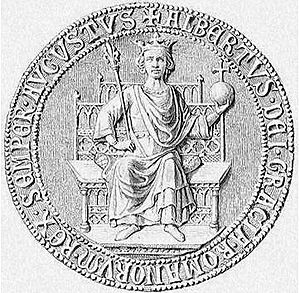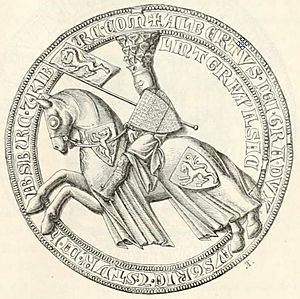Albert I of Germany facts for kids
Quick facts for kids Albert I |
|
|---|---|

Seal of Albert I, showing his title: "Albert by the grace of God King of the Romans, ever majestic"
|
|
| King of Germany | |
| Reign | 27 July 1298 – 1 May 1308 |
| Coronation | 24 August 1298 Aachen Cathedral |
| Predecessor | Adolph |
| Successor | Henry VII |
| Born | July 1255 Imperial City of Rheinfelden |
| Died | 1 May 1308 (aged 52) Windisch, Further Austria |
| Burial | Speyer Cathedral |
| Spouse | Elizabeth of Carinthia |
| Issue | Rudolph I of Bohemia Frederick the Fair Leopold I, Duke of Austria Albert II, Duke of Austria Henry the Gentle Otto, Duke of Austria Anna, Margravine of Brandenburg and Duchess of Wrocław Agnes, Queen of Hungary Elizabeth, Duchess of Lorraine Catherine, Duchess of Calabria Judith, Countess of Öttingen |
| House | House of Habsburg |
| Father | Rudolph I of Germany |
| Mother | Gertrude of Hohenberg |
Albert I of Habsburg (also known as Albrecht I.) was born in July 1255 and died on May 1, 1308. He was a powerful ruler from the House of Habsburg. He became the Duke of Austria and Styria in 1282. Later, he was chosen as King of Germany in 1298 and ruled until he was killed.
Albert was the oldest son of King Rudolf I of Germany. He was sometimes called 'Albert the One-eyed'. This was because of an injury he got in battle. It left him with a damaged eye and a permanent snarl.
Contents
Albert's Early Life and Rise to Power
From 1273, Albert ruled over his father's lands in Alsace. These lands were part of Swabia. In 1282, his father, King Rudolf I, gave Albert and his younger brother Rudolf II control of the Duchies of Austria and Styria. His father had won these lands from King Ottokar II of Bohemia.
In 1283, Albert's father decided that Albert alone would govern these duchies. His brother Rudolf II was supposed to get other family lands as a trade. But this never happened. Albert and his helpers ruled Austria and Styria very well. They managed to overcome resistance from local nobles.
Becoming King of Germany
Albert's father, King Rudolf I, tried to make Albert his successor as King of Germany. But other powerful princes, called Prince-electors, did not want Albert to become king. They were afraid he would make the kingship a family right, passed down from father to son. So, after Rudolf's death in 1291, they chose Count Adolf of Nassau-Weilburg as the new King of the Romans (another name for the German king).
Albert had to accept Adolf's rule for a while. But he still hoped to become king. In 1298, some princes changed their minds. They were unhappy with King Adolf. So, they chose Albert to be the new German king. Albert's army then met Adolf's army at the Battle of Göllheim. Adolf was defeated and killed in this battle.
After this victory, Albert was chosen again as king on July 27, 1298. He was crowned in Aachen Cathedral on August 24.
Albert's Rule and Policies
Albert was a strong and serious ruler. But he was also known for being fair, especially when it didn't go against his own plans. He was very smart and practical.
He supported the growth of cities. He also worked with princes to stop private wars. He even protected serfs (people who worked on the land and were tied to it) and the Jewish people. This was unusual for his time. Stories about him being cruel in the Swiss areas, like the legend of William Tell, appeared much later. Historians now believe these stories are not true.
Albert wanted to be important in European politics. At first, he had disagreements with France. But then Pope Boniface VIII refused to recognize him as king. So, Albert changed his plans. In 1299, he made a treaty with King Philip IV of France. Later, in 1303, the Pope finally recognized Albert as the German king and future emperor. In return, Albert agreed that only the Pope could give the Imperial crown. He also promised that his sons would not be elected king without the Pope's approval.
Albert tried to gain more land for his family. In 1306, he helped his son Rudolph III become King of Bohemia. He also tried to claim lands in Thuringia. However, this led to his defeat at the Battle of Lucka in 1307. In the same year, his son Rudolph died, which weakened Albert's power in Eastern Europe.
Albert also tried to remove all tolls (taxes) on the Rhine river that had been put in place since 1250. This made some powerful archbishops and princes angry. They formed a group against him. But with the help of the Imperial cities, Albert quickly put down this uprising.
Death
Albert was on his way to stop a revolt in Swabia. On May 1, 1308, he was murdered by his nephew, Duke John. This happened near Windisch on the Reuss. His nephew was later called "John the Parricide" because he killed a family member.
Titles Held by Albert I
Albert held many important titles during his life:
- King of the Romans (German King)
- Duke of Austria and Styria
- Lord of Carniola
- Count of Habsburg and Kyburg
- Landgrave of Alsace
Family Life
In 1274, Albert married Elizabeth. She was the daughter of Count Meinhard II of Tyrol. Elizabeth was also related to earlier German kings and powerful dukes.
Albert and Elizabeth had twelve children:
- Anna (1275–1327)
- Agnes (1281–1364)
- Rudolph III (around 1282–1307)
- Elizabeth (1285–1353)
- Frederick I (1289–1330)
- Leopold I (1290–1326)
- Catherine (1295–1323)
- Albert II (1298–1358)
- Henry the Gentle (1299–1327)
- Meinhard (1300–1301), who died as a baby.
- Otto (1301–1339)
- Jutta (1302–1329)
See also
 In Spanish: Alberto I de Habsburgo para niños
In Spanish: Alberto I de Habsburgo para niños



